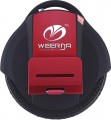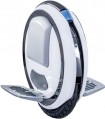Max. load
The maximum rider weight that the device can support (including the weight of a backpack, bag and other things carried on oneself; this is especially important to remember if the weight of the person himself is close to the maximum allowable). If the permissible load is exceeded, the transport not only loses efficiency but can also break down at any time. Therefore, it is impossible to ignore the prescriptions for weight anyway.
Range
The average distance that can be driven on a single battery charge. Usually, the range is indicated with some overestimation — based on a low (optimal from the point of view of energy consumption) speed, uniform movement on a flat surface, etc. Therefore, the actual battery life may be somewhat less. Nevertheless, this parameter is quite suitable for comparing different models with each other.
Thanks to the development of technology, the range in modern self-balancing vehicles can reach
several tens of kilometers.
Max. speed
The maximum speed that the hoverboard is capable of reaching: on a flat surface, with a full battery charge and an average rider weight. The same parameter is also the maximum safe speed allowed when using this model; in theory, it is possible to accelerate even faster (for example, from a mountain), but this is fraught with breakdown, accident and injury, and therefore is not recommended at all.
Most modern models have a maximum speed of up to 20 km/h, and in “high-speed” vehicles this figure can exceed 30 km/h. Note that a fall from a hoverboard, even at a speed of 10 – 15 km/h, is fraught with serious injuries. Therefore, protective gear is highly recommended.
Wheel size
The diameter of the wheels used in the vehicle. Technically,
larger wheels contribute to rolling ability and reduce sensitivity to obstacles and small bumps. However, these possibilities are influenced by many other factors, not least the engine power: with a weak engine, the unit may not have time to cope with the obstacle, which will lead to the rider falling forward. Therefore, large wheels must be combined with a powerful engine.
By itself, information about the diameter of the wheel can be useful when repairing or replacing it.
Max. climb angle
The maximum angle of inclination of the surface at which the vehicle can normally drive up or down (in some models, this parameter is indicated only for one direction, for example, up).
This parameter characterizes the ability of the device to overcome ups and downs. In modern models, it can reach 45 °. At the same time, note that the ability to cope with large angles requires not only powerful motors, but also appropriate design features (in particular, so that the protective cover does not scrape the ground); and for the descent, the second is even more important than the first. Therefore, when choosing a model for frequent driving on slopes, you should pay attention not only to power, but also to the angle of inclination directly stated in the specs.
Also note that at a high load (approaching the maximum), the efficiency of overcoming climbs may decrease. On the other hand, some manufacturers indicate the angle of inclination at the maximum load, and clarify that the light weight of the rider allows you to overcome steeper climbs than originally stated.
Clearance
Clearance is the distance from the lowest point of the hull to the ground; in other words, this is the largest size of an obstacle on the road (in height), that the device can pass under itself. High clearance contributes to cross-country ability. However, it requires large-diameter wheels and, accordingly, an increase in motor power, which in turn affects the weight and price of the device. In addition, self-stabilizing transport is designed primarily for urban use, with driving on a flat surface. Therefore, even in most models, the clearance does not exceed 150 mm, and in some devices, it is only 30 mm.
More features
—
Position lights. The dimensions of the self-stabilizing transport are small, so such lights not only highlight the dimensions of the vehicle, but increase its visibility. This function is especially important at night — for safety, both for the rider and those around him. And in some countries, operation without position lights is prohibited by law.
In models that do not have front and rear sides as such and can drive equally efficiently in either direction, position lights are often made in the form of switchable two-colour lights: for example, the device turns on white light from the side it is currently traveling to, and red on the opposite side of the case.
— Bluetooth. This feature turns the vehicle into a mobile speaker system: you can connect an external Bluetooth device (for example, a smartphone) to it and listen to music through the
built-in speakers during the ride.
—
USB port. Usually, this port is intended for charging smartphones or other gadgets from the built-in battery — thus, the vehicle turns into an external battery (power bank). At the same time, given the impressive battery capacity in a self-stabilizing vehicle, charging an external gadget has practically no effect on the power reserve — especially since we are most often talking about a minimum charge replenishment, and not about charging up to 100%.
...— Remote control. Such control can be carried out both from a separate remote control supplied in the kit, and via a smartphone (usually via Bluetooth) using a proprietary application. Specific control options can be different — up to the tracking mode, when the device itself follows the owner at a certain distance. However, anyway, this function significantly expands the possibilities of transport.Battery capacity
Battery capacity of the device in milliamp-hours (mAh)
This parameter characterizes the amount of energy that the battery can store. The
higher the number the more energy the battery stores, respectively, the greater the range (see above) and the more time it will take to charge. However, mAh is a popular, but not very reliable unit of power measurement: the actual amount of stored energy depends not only on the “milliamp hours”, but also on the battery voltage (and it can vary greatly in different models). The actual battery life strongly depends on the power consumption of the unit (determined primarily by engine power). This means that only models with similar performance characteristics and the same battery voltage can be compared with each other in this indicator. And when choosing, it’s easier to focus on more practical indicators — first of all, the range.
Battery capacity
The battery capacity of the device in watt-hours (Wh).
In general, capacity shows the amount of energy that a battery can store. The higher the number, the more energy the battery stores, respectively, the greater the range (see above) and the more time it will take to charge. Note that although watt-hours are used to designate power much less frequently than milliamp-hours (see above), this designation is more reliable, because when evaluating capacity, in this case, the battery voltage is also taken into account (as opposed to counting in mAh). This makes it easy to compare batteries of different voltages. At the same time, do not forget that the energy consumption of different models can also be different, and battery life is easier to evaluate by the directly claimed range.

